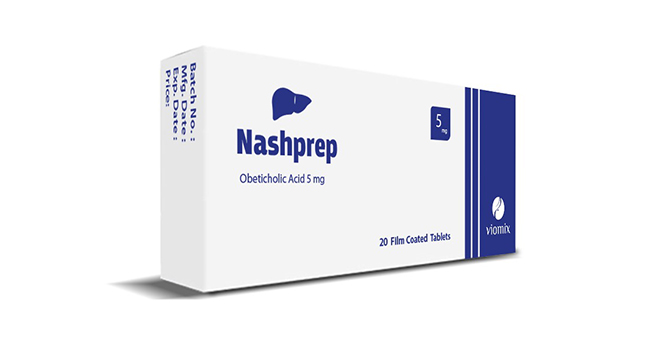
Obeticholic Acid, Cutting Edge Molecule for Primary Biliary Cholangitis
Each Film Coated Tablet Contains:
| ► Obeticholoc Acid | 5 mg |
NASHPREP is indicated for the treatment of primary biliary cholangitis
(also known as primary biliary cirrhosis)
► In combination with ursodeoxycholic acid (UDCA) in adults with an inadequate response to UDCA
► As monotherapy in adults unable to tolerate UDCA.
Pharmacodynamic Properties Pharmacotherapeutic Group:
Bile Acid Preparations, ATC code: A05AA04
Mechanism of Action:
Obeticholic acid is a selective and potent agonist for the farnesoid X receptor (FXR), a nuclear receptor expressed at high levels in the liver and intestine. FXR is thought to be a key regulator of bile acid, inflammatory, fibrotic, and metabolic pathways. FXR activation decreases the intracellular hepatocyte concentrations of bile acids by suppressing de novosynthesis from cholesterol, as well as, by increasing transport of bile acids out of the hepatocytes. These
mechanisms limit the overall size of the circulating bile acid pool while promoting choleresis, thus reducing hepatic exposure to bile acids.
Pharmacokinetic Properties:
►Absorption Obeticholic acid is absorbed with peak plasma concentrations (Cmax) occurring at a median time (tmax) of approximately 2 hours. Co-administration with food does not alter the extent of absorption of Obeticholic acid.
►Distribution Human plasma protein binding of Obeticholic acid and its conjugates is greater than 99%. The volume of distribution of Obeticholic acid is 618 L. The volume of distributions of glyco- and tauro-obeticholic acid has not been determined.
►Biotransformation Obeticholic acid is conjugated with glycine or taurine in the liver and secreted into bile. These glycine and taurine conjugates of Obeticholic acid are absorbed in the small intestine leading to enterohepatic recirculation. The conjugates can be deconjugated in the ileum and colon by intestinal microbiota, leading to the conversion to Obeticholic acid that can be reabsorbed or excreted in faeces, the principal route of elimination. After daily administration of Obeticholic acid, there was accumulation of the glycine and taurine conjugates of Obeticholic acid which have in vitro pharmacological activities similar to the parent drug. The metabolite-to-parent ratios of the glycine and taurine conjugates of Obeticholic acid were 13.8 and 12.3, respectively, after daily administration. An additional third Obeticholic acid metabolite, 3-glucuronide is formed but is considered to have minimal pharmacologic activity.
►Elimination After administration of radiolabeled Obeticholic acid, greater than 87% is excreted in faeces. Urinary excretion is less than 3%.
►Dose/Time proportionality Following multiple-dose administration of 5, 10, and 25 mg once daily for 14 days, systemic exposures of Obeticholic acid increase dose proportionally. Exposures of glyco- and tauro-obeticholic acid, and total Obeticholic acid increase more than proportionally with dose.
Kindly Read the Attached Leaflet Carefully, Necessary Valuable Information is Still Available
Kindly, Revise the Attached Leaflet Carefully, Necessary Valuable Information is Still Available
Liver Related Adverse Events
Elevations in alanine amino transferase (ALT) and aspartate aminotransferase (AST) have been observed in patients taking Obeticholic acid. Clinical signs and symptoms of hepatic decompensation have also been observed. These events have occurred as early as within the first month of treatment. Liver-related adverse events have primarily been observed at doses higher than the maximum recommended dose of 10 mg once daily (see section 4.9). In the post marketing setting, serious liver injury and death have been reported with more frequent dosing of Obeticholic acid than recommended in patients with moderate to severe decreases in liver function.
After initiation of therapy, all patients should be monitored for progression of PBC disease with laboratory and clinical assessment to determine whether dosage adjustment is needed.
Patients at an increased risk of hepatic decompensation, including those with laboratory evidence of worsening liver function and /or progression to cirrhosis, should be monitored more closely. Dosing frequency should be reduced for patients who progress to advanced disease (i.e. from Child-Pugh Class A to Child-Pugh Class B or C) (see sections 4.2 and 5.2).
Severe Pruritus
Severe pruritus was reported in 23% of patients treated with NASHPREP 10 mg arm, 19% of patients in the NASHPREP titration arm, and 7% of patients in the placebo arms. The median time to onset of severe pruritus was 11, 158, and 75 days for patients in the Obeticholic acid 10 mg, Obeticholic acid titration, and placebo arms, respectively. Management strategies include the addition of bile acid binding resins or antihistamines, dose reduction, reduced dosing frequency, and/or temporary dose interruption (see sections 4.2 and 4.8).
Kindly read The Attached Leaflet Carefully, Valuable Necessary Information Still Available
1
5/5